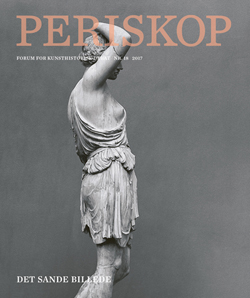Den udtømte sandhed og den sande uudtømmelighed
DOI:
https://doi.org/10.7146/periskop.v15i18.110203Resumé
The Exhausted Truth and the True Inexhaustibility
What are the relations between images and truth? How can truth be represented? In the
article “The Exhausted Truth and the True Inexhaustibility”, the German romanticist and
philosopher Friedrich Schlegel’s theories concerning the great value and unmeasurable
importance of the endless, the unintelligible, and the inexhaustible serves as the opening
to a discussion of what is to be understood by the question of truth. Does truth pertain
to the forever unsayable domains of the oblique and evasive – that which must remain
outside the firm grasp of enlightenment and understanding? Or, on the contrary, is truth
that which not only can be enframed, but also reproduced and represented? The discussion
of this question brings forth a fundamental divide between Schlegel’s and Romanticism’s
idealizations of the creative and vitalistic transgressions of the human limits of
understanding and the boundaries set up in the names of enlightenment and knowledge.
As argued in the article, this divide would also describe a discrepancy between, on the one
hand, a contemplative search into the unknown depths of the world, and, on the other
DEN UDTØMTE SANDHED OG DEN SANDE UUDTØMMELIGHED 43 PERISKOP NR. 18 2017
hand, the desire to bring into light, into form, and into image. The Information Age in
which we are said to live today would appear to provide us first and foremost with the
latter image of truth: The substitution of Romanticism’s inexhaustive image of truth with
the true exhaustiveness of our image culture.
Downloads
Publiceret
Citation/Eksport
Nummer
Sektion
Licens
Forfattere, der publicerer deres værker via dette tidsskrift, accepterer følgende vilkår:
- Forfattere bevarer deres ophavsret og giver tidsskriftet ret til første publicering, samtidigt med at værket 12 måneder efter publiceringen er omfattet af en Creative Commons Attribution-licens, der giver andre ret til at dele værket med en anerkendelse af værkets forfatter og første publicering i nærværende tidsskrift.
- Forfattere kan indgå flere separate kontraktlige aftaler om ikke-eksklusiv distribution af tidsskriftets publicerede version af værket (f.eks. sende det til et institutionslager eller udgive det i en bog), med en anerkendelse af værkets første publicering i nærværende tidsskrift.
- Forfattere har ret til og opfordres til at publicere deres værker online (f.eks. i institutionslagre eller på deres websted) forud for og under manuskriptprocessen, da dette kan føre til produktive udvekslinger, samt tidligere og større citater fra publicerede værker (se The Effect of Open Access).


